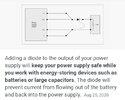Hi
I have a question about switching power supply 5v 30 amps.
When I'm connecting it to tungsten filament wire 0.5 mm 3 cm long , after a time the power supply stops working. I think this is because of short protection. Are there any way to bypass this or you can advise me with another type of power supply.
Thanks in advance
I have a question about switching power supply 5v 30 amps.
When I'm connecting it to tungsten filament wire 0.5 mm 3 cm long , after a time the power supply stops working. I think this is because of short protection. Are there any way to bypass this or you can advise me with another type of power supply.
Thanks in advance


